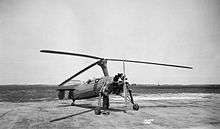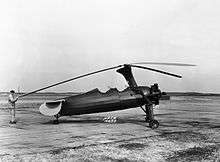Kellett KD-1
| Kellett KD-1 | |
|---|---|
_37-381_Yanks_05.01.08R.jpg) | |
| Kellett XR-3 modification of YG-1B (KD-1) of U.S. Army preserved at Yanks Air Museum, Chino airfield California, in January 2008 | |
| Role | Autogyro |
| National origin | United States |
| Manufacturer | Kellett Autogiro Company |
| First flight | 1934 |
| Primary users | United States Army Air Forces Eastern Airlines |
| Variants | Kayaba Ka-1 |
The Kellett KD-1 was a 1930s American autogyro built by the Kellett Autogiro Company. It had the distinction of being the first practical rotary-wing aircraft used by the United States Army and inaugurated the first scheduled air-mail service using a rotary-wing aircraft.
Development
Using the experience gained in building Cierva autogyros under licence the Kellett Autogiro Company developed the KD-1 which was similar to the contemporary Cierva C.30. It had two open cockpits, a fixed tailwheel landing gear and was powered by a 225 hp (168 kW) Jacobs L-4 radial engine. After testing of the prototype a commercial variant designated the KD-1A was put into production. The KD-1A had a three-bladed rotor with folding blades and a number of minor detail improvements. A KD-1B which was a KD-1A with an enclosed cockpit for the pilot was operated by Eastern Airlines and inaugurated the first scheduled rotary-wing air-mail service on 6 July 1939.
In 1935 the United States Army bought a KD-1 for evaluation and designated it the YG-1, a second aircraft followed which had additional radio equipment and was designated the YG-1A. These two aircraft were followed by a batch of seven designated YG-1B. In 1942 seven more were bought for use in the observation role as the XO-60. Six XO-60s were re-engined with 300 hp (224 kW) Jacobs R-915-3s and re-designated YO-60.[1] One YG-1B was modified with a constant-speed rotor and was re-designated the YG-1C, it was later re-engined with the more powerful R-915 and re-designated again as the XR-2. The XR-2 was destroyed by rotor ground resonance problems and the evaluation was continued with another modified YG-1B designated the XR-3.
Variants

- KD-1
- Prototype, one built
- KD-1A
- Commercial variant with open cockpit and a 225 hp (168 kW) Jacobs L-4 radial engine; three built.
- KD-1B
- Commercial variant with enclosed cockpit; two built.
- YG-1
- United States Army designation for one KD-1A acquired for evaluation.
- YG-1A
- One aircraft as YG-1 with the addition of radio equipment.

- YG-1B
- Production aircraft for the United States Army; seven built.
- YG-1C
- One YG-1B modified with a constant-speed rotor for evaluation, later designated the XR-2.

- XO-60
- Production aircraft for the United States Army with a 225 hp (168 kW) Jacobs R-755 radial engine, seven built.
- YO-60
- Six XO-60s re-engined with a 300 hp (220 kW) Jacob R-915-3 radial engine.
- XR-2
- The YG-1C re-designated after being re-engined with a 300 hp (220 kW) Jacobs R-915-3 radial engine.
- XR-3
- One YG-1B modified to XR-2 standard for evaluation.
- Kayaba Ka-Go prototype
- Prototype; it was an airframe which had repaired KD-1A by Kayaba.
- Kayaba Ka-1
- Imperial Japanese Army developed referring to KD-1A. Powered by a 240 hp (180 kW) Argus As 10 engine, airframe that changed engine of prototype.
- Kayaba Ka-2
- Imperial Japanese Army developed referring to KD-1A. Powered by a 245 hp (183 kW) Jacobs L-4MA-7 engine, airframe that changed engine of Ka-1 for the same thing as prototype.
Operators
Specifications (KD-1B)
General characteristics
- Crew: 2
- Length: 28 ft 10 in (8.79 m)
Performance
See also
- Related development
- Aircraft of comparable role, configuration and era
- Related lists
References
Notes
- ↑ "ARMY AUTOGIRO" Popular Science, June 1944, photo of YO-60
Bibliography
- Taylor, Michael J. H. (1989). Jane's Encyclopedia of Aviation. London: Studio Editions.
- The Illustrated Encyclopedia of Aircraft (Part Work 1982-1985). Orbis Publishing.
- Andrade, John (1979). U.S.Military Aircraft Designations and Serials since 1909. Midland Counties Publications. ISBN 0-904597-22-9.
External links
![]() Media related to Kellett KD-1 at Wikimedia Commons
Media related to Kellett KD-1 at Wikimedia Commons